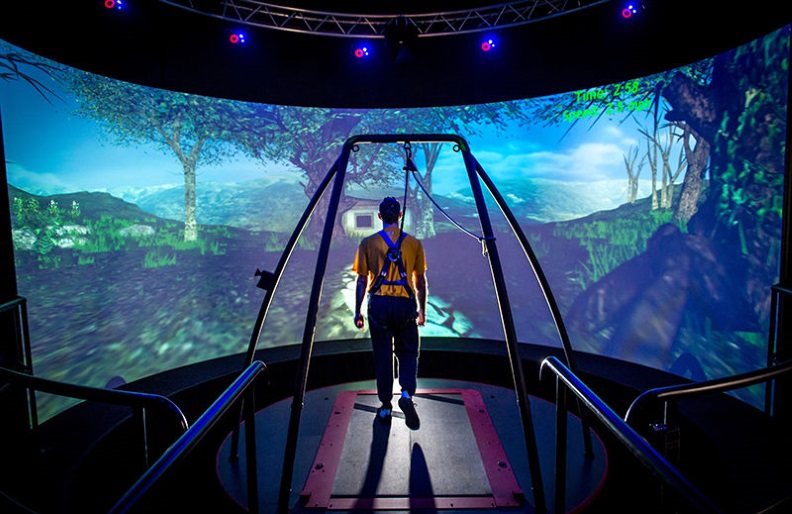You strap on the head-mounted display, slip on the gloves, tune your ears to the surround sound — and suddenly you are facing a plank jutting out over an abyss. The depths here are virtual, but not everyone can force themselves to jump.
This is just one program developed by psychologist Jeremy Bailenson to demonstrate the capabilities of virtual reality (VR). As a leading researcher in the field, Bailenson crafts new worlds that feel real, to explore their beneficial uses. In Experience On Demand, he tours the myriad applications that he and others are developing. After a great deal of hype by science-fiction film writers and video-game designers in the 1990s, the technology now finally seems poised for widespread use. Eventually, as Bailenson details, it could transform work, schools, hospitals and more.
Fast, high-resolution VR systems such as Bailenson’s excel as training tools because they so effectively recreate interaction with a particular environment: a user’s motor and perceptual systems interact with the surroundings more or less as they would with the real thing. Psychologists refer to this as “presence”; it is, as Bailenson notes, “the fundamental characteristic of VR”. The system tracks your every move, providing a realistically shifting sensory perspective. Small things loom as you move towards them; the view turns as you rotate your head. Props or a shaking floor can make an experience feel very real indeed.
The applications, as Bailenson details, are legion. VR is an efficient way to train workers in dangerous or challenging jobs. For example, quarterbacks in American football need daily strategy practice alongside their cardio and weights, to prepare for every possible defence. Bailenson developed a training program for the team at Stanford University in California; he has now expanded it into STRIVR, a company offering immersive training. The firm provides tools that claim to improve performance and boost productivity in a range of companies and sports teams.
VR also lends itself to social, ethical and environmental education. Bailenson discusses examples of how it could be used to tackle ageism and reduce waste. The idea is that it can give users any kind of body. In one of Bailenson’s studies, for instance, participants who were given an ‘elder’ avatar and saw themselves in a virtual mirror showed a 20% improvement against ageist stereotypes in one measure of bias. This was a word-association task posing questions such as “When you think of somebody old, what are the first five words that come to mind?”; people who had experienced the elder avatar used more positive words. However, the tactic backfired with respect to race. White people who tried on a black avatar subsequently scored worse in a test of implicit bias. In this case, rather than boosting empathy, the virtual experience primed racist stereotypes.
Programs can also be used for physical and psychological therapy. People with burn injuries experienced up to 44% less pain when using VR because the immersive environment was such an efficient distraction, according to a study by psychologist Hunter Hoffman at the University of Washington in Seattle and his colleagues (Y. S. Schmitt et al. Burns 37, 61–68; 2011). VR has also been used to help people with post-traumatic stress disorder to gradually come to terms with their traumatic experience.
There are inevitable risks and drawbacks. Mayank Mehta, a neurophysicist at the University of California, Los Angeles, investigated the effects of the technology on the brains of laboratory rats. His team found that rats respond to the sight of a virtual dispenser of sugar water as if it is the real thing, running faster towards it and even salivating and licking as they (virtually) approach it — a sign of addiction (Z. M. Aghajan Nature Neurosci. 18, 121–128; 2015). In a 2014 study by Frank Steinicke and Gerd Bruder at the University of Hamburg in Germany, a participant started blurring the distinctions between real and virtual objects after immersion in a virtual environment many times in a single day (F. Steinicke and G. Bruder Proc. 2nd ACM Symp. on Spatial User Interaction 66–69; 2014).
Bailenson mentions escapist, excessive use of VR as a major risk. Because of “simulator sickness” and eye strain, which can develop after just 20 minutes, this has not yet been studied in humans. It is as yet a speculative concern, explored more in film and fiction. In addition, there are concerns that violent programs, such as VR versions of first-person-shooter video games, might encourage antisocial or aggressive behaviour in the real world. But Bailenson gives such concerns short shrift. Nor does he call for transparency or oversight of VR companies, or for regulations to ensure consumers’ safety. He seems confident that developers and users will know how to use the technology responsibly.
Indeed, Bailenson is, by his own admission, “bullish” about VR; he recognizes that he might have “drunk the Silicon Valley Kool-Aid”. That relentless positivity means that the book can lack nuance, as if VR can solve the world’s problems. Bailenson, for instance, wants to combat climate change by using the technology to encourage people to change their behaviour, for example by taking shorter showers and making fewer long-distance flights. He also wants to see it used in schools for virtual field trips — although the cost of the equipment would make access unequal.
Social-media trolls pose another problem. Platforms such as Facebook — which acquired the VR company Oculus in 2014 — could one day incorporate virtual interactions, raising the chilling spectre of increasingly realistic goading and abuse. Bailenson often writes like a scientist. His prose can be verbose, peppered with jargon such as “boundary conditions”. He verges on the grandiose, calling VR a “movement” or a “revolution”. Nevertheless, his enthusiasm is contagious, and he explains complex issues to an audience broader than fellow scientists, providing a real vision of our possibly VR‑infused future.
This article was originally published by Nature.
